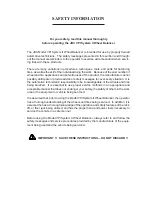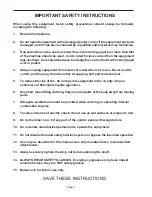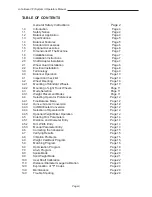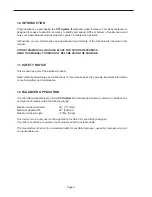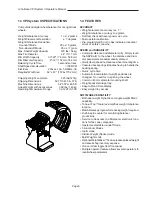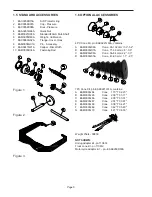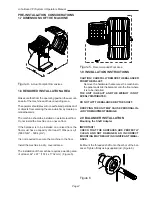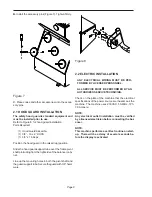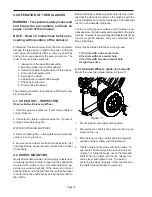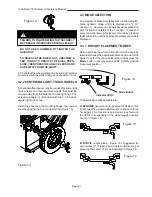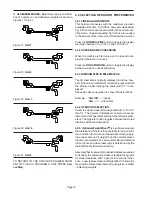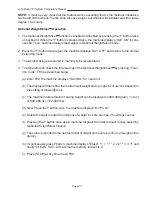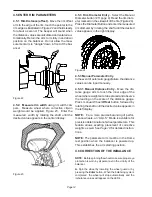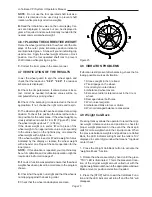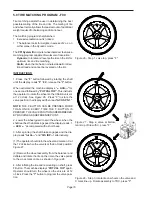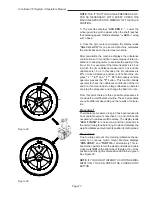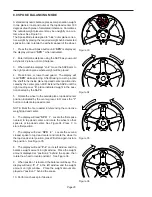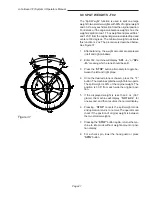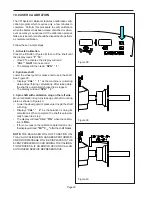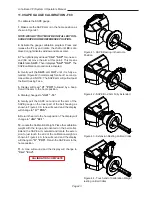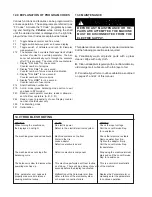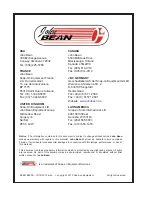
Page 15
John Bean VPI System II Operators Manual
NOTE
: Do not use the foot operated shaft lock as a
brake, it is intended to be used only to prevent shaft
rotation while placing corrective weights.
B.
Read the imbalance value on the outer display. Val-
ues are displayed in ounces but can be displayed in
grams if required and are automatically rounded to the
nearest commercial wheel weight.
4.6.1 PLACING THE CORRECTIVE WEIGHT
Raise the wheel guard and turn the wheel until the dis-
plays of the outer plane imbalance position indicator
are illuminated green. A tone will sound indicating top
dead center. Apply the wheel weight at twelve o’clock
position. Use the foot operated shaft lock to prevent
shaft rotation while placing weights.
C.
Correct the inner plane in the same manner.
4.7 VERIFICATION OF THE RESULTS
Lower the wheel guard to spin the wheel again and
check that the readout is
“0.00” “0.00”
If a residual
imbalance is displayed:
A.
Check the rim parameters, if entered value is incor-
rect, correct as needed. Imbalance values will be re-
computed after re-spinning wheel.
B.
Check if the balancing mode selected is the most
appropriate. If not, choose the right mode and respin.
C.
The wheel weight could have been placed at a wrong
position. To check this, position the wheel at the correc-
tion position for the outer plane. If the wheel weight pre-
viously attached is in sector ‘
L
’ or ‘
R
’ ( Figure 25), move
the wheel weight up about 1” (2.54cm).
If the wheel weight is in sector ‘
D
’ cut a piece of the
wheel weight of an approximate value corresponding
to the value shown on the right display, or replace the
wheel weight with a lighter one.
If the wheel weight is in sector ‘
U
’ add a weight of value
indicated by the display or replace the wheel weight
with a heavier one. Repeat the same operation for the
inner plane.
NOTE:
If this situation is repeated, your machine may
be out of calibration and a calibration operation might be
required as instructed on page 21.
D.
If an
ALU
function was selected ensure that the wheel
weights have been placed in accordance to the program
chosen.
E.
Check that the quick nut is tight and that the wheel is
not slipping against the backing collar.
F.
Check that the wheel and adaptors are clean.
Figure 25
4.8 VIBRATION PROBLEMS
If vibration is still present after balancing, check the fol-
lowing possible sources of vibration:
1. Stones caught in the tire tread.
2. Tire slippage on the wheel.
3. Incorrectly mounted wheel.
4. Imbalanced wheel covers.
5. Excessive radial or lateral runout in the tire or
wheel.
6. Damaged wheel bolt holes.
7. Worn universal joints.
8. Imbalanced brake rotors or drums.
9. Worn or damaged balancer accessories
4.9 Weight Call-Back
Pressing this key allows the operator to recall the origi-
nal weight imbalance value and position to check for
proper weight placement in the event the check spin
calls for more weight when in the clip-clip mode. When
the previous balance weights and positions are Called
Back, the LED indicator will light and the letters “tdc”
displayed in center digit window that means “top dead
center check”.
1. Press the Weight Call-Back button to activate the
“weight call back” function.
3. Rotate the wheel assembly by hand until the green
“TDC” LED is illuminated. This is the placement loca-
tion of the original weight amount called out with the
original weight amount shown in the appropriate windows.
Make amount or position correction if needed.
4. Press the [STOP] button to exit the Call Back Func-
tion and the LED indicator will turn off and the “tdc” will
disappear.
Summary of Contents for VPI SYSTEM II
Page 2: ......
Page 27: ...NOTES ...

